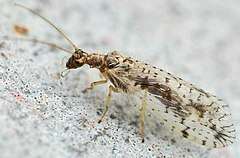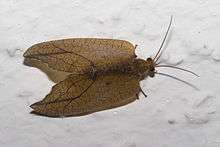Hemerobiidae
Hemerobiidae is a family of Neuropteran insects commonly known as brown lacewings, comprising about 500 species in 28 genera. Most are yellow to dark brown, but some species are green. They are small; most have forewings 4–10 mm long (some up to 18 mm). These insects differ from the somewhat similar Chrysopidae (green lacewings) not only by the usual coloring but also by the wing venation: hemerobiids differ from chrysopids in having numerous long veins (two or more radial sectors) and forked costal cross veins. Some genera (Hemerobius, Micromus, Notiobiella, Sympherobius, Wesmaelius) are widespread, but most are restricted to a single biogeographical realm. Some species have reduced wings to the degree that they are flightless.[1] Imagines (adults) of subfamily Drepanepteryginae mimic dead leaves. Hemerobiid larvae are usually less hairy than chrysopid larvae.
| Brown lacewings | |
|---|---|
 | |
| Adult Micromus variegatus (Microminae) | |
| Scientific classification | |
| Kingdom: | |
| Phylum: | |
| Class: | |
| Order: | |
| Suborder: | |
| Superfamily: | Hemerobioidea |
| Family: | Hemerobiidae Latreille, 1802 |
| Subfamilies | |
|
10, see text | |
| Synonyms | |
|
Promegalomidae | |
.jpg)
Hemerobiids, like chrysopids, are predatory, especially on aphids, both as larvae and adults. The species Micromus tasmaniae is bred for biological pest control.[2]
Systematics
The relationships between the Hemerobiidae and the other Neuropteran families are still unresolved.[3] Despite their superficial similarity to chrysopids, the brown and green lacewings may not be as closely related as was at one time believed. Rather, the Hemerobiidae appear to be closely related to the Mantispidae.[4][5]
The superfamily Hemerobioidea is currently restricted to the Hemerobiidae. Formerly, the pleasing lacewings (Dilaridae), silky lacewings (Psychopsidae), giant lacewings (Polystoechotidae) and as noted above the green lacewings (Chrysopidae) were placed therein too. Of these, only the Dilaridae and Chrysopidae seem to be reasonably close relatives of the brown lacewings. The Psychopsidae in fact seem to belong to an altogether different suborder of Neuroptera, the Myrmeleontiformia.[3]
Phylogeny
Cladogram of Hemerobiidae relations, based on morphological and molecular data. Psychobiellinae was rearranged into Notiobiellinae and Zachobiellinae, and Adelphohemerobiinae was placed as incertae sedis. [6]
| Hemerobiidae |
| |||||||||||||||||||||||||||||||||||||||||||||
Genera
The subfamilies of Hemerobiidae are:

|
|
Apart from the genera assigned to subfamilies, the genus Notherobius is of uncertain or fairly basal position.
Fossils

Numerous fossil Hemerobiidae have been described, some from the still-living genera, others from genera that are entirely extinct today. While most have been found in Eocene to Miocene rocks or amber, Promegalomus is known from the Jurassic. It was formerly considered to constitute a distinct family Promegalomidae, but is currently recognized as a very basal member of the Hemerobiidae. The Cretaceous Mesohemerobius was formerly considered a brown lacewing, but is today rather placed as incertae sedis in the Neuroptera; it might be a member of the Hemerobioidea but not even that is certain. Notable fossil Hemerobiidae genera are:[8]
- Bothromicromus Scudder, 1878 (Eocene/Oligocene; Quesnel, British Columbia)
- Brasilopsychopsis (Cretaceous, Crato Formation Brazil)
- Cratopsychopsis (Cretaceous, Crato Formation Brazil)
- Cretomerobius Ponomarenko, 1992 (Cretaceous to Ecoene; Bon-Tsagan, Mongolia; Klondike Mountain Formation, Washington)
- Mucropalpus Pictet, 1856 (Eocene; Baltic amber)
- Prochlanius Kruger, 1923 (Eocene; Baltic amber)
- Promegalomus Panfilov, 1980 (Jurassic; Chimkent Oblast, Kazakhstan)
- Prophlebonema Kruger, 1923 (Eocene; Baltic amber)
- Prospadobius Kruger, 1923 (Eocene; Baltic amber)
The extinct genus Hemerobites was originally described in 1813 from a specimen preserved in Baltic amber as a hemerobiid. However further study has resulted in its synonymy with the genus Eutermes and placement in the termite subfamily Termitina. The species Wesmaelius mathewesi, was described in 2003 from a solitary Eocene fossil found near Quesnel, British Columbia, and placed into the extant genus Wesmaelius. At that time it was the oldest Hemerobiinae species described.[9] Another species from the same genus, Wesmaelius makarkini was found in Garang Formation of Zeku County, Qinghai Province, China, in 2018. The finding is from Lower Miocene.[7]
Some additional brown lacewing larvae have been found as fossils, but it has been impossible to determine their generic or subfamilial association.[8]
References
- Stange, Lionel (2008). "Lacewings, Antlions and Matispids (Neuroptera)". In Capinera, John L. (ed.). Encyclopedia of entomology (2nd. ed.). Dordrecht: Springer. pp. 2102–2110. ISBN 978-1-4020-6242-1.
- New, TR (2002). "Prospects for extending the use of Australian lacewings in biological control" (PDF). Acta Zoologica Academiae Scientiarum Hungaricae. 48 (Supplement 2): 209–216.
- Aspoeck, Ulrike; Haring, Elisabeth; Aspoeck, Horst (2012). "The phylogeny of the Neuropterida: long lasting and current controversies and challenges (Insecta: Endopterygota)" (PDF). Arthropod Systematics & Phylogeny. 70 (2): 119–129. Retrieved 12 September 2016.
- Winterton, Shaun L.; Hardy, Nate B.; Wiegmann, Brian M. (July 2010). "On wings of lace: Phylogeny and Bayesian divergence time estimates of Neuropterida (Insecta) based on morphological and molecular data". Systematic Entomology. 35 (3): 349–378. doi:10.1111/j.1365-3113.2010.00521.x.
- Zhao, Yang; Chen, Yunjiao; Zhao, Jing; Liu, ZhiQi (2015). "First complete mitochondrial genome from the brown lacewings (Neuroptera: Hemerobiidae)". Mitochondrial DNA Part A. 27 (4): 2763–2764. doi:10.3109/19401736.2015.1053054. PMID 26367792.
- Garzón-Orduña, IJ; Menchaca-Armenta, I; Contreras-Ramos, A; Liu, X; Winterton, SL (20 September 2016). "The phylogeny of brown lacewings (Neuroptera: Hemerobiidae) reveals multiple reductions in wing venation". BMC Evolutionary Biology. 16: 192. doi:10.1186/s12862-016-0746-5. PMC 5029026. PMID 27645380.
- Yang, Qiang; Shi, Chaofan; Li, Xiangchuan; Pang, Hong; Ren, Dong (2018-01-10). "The first fossil brown lacewing from the Miocene of the Tibetan Plateau (Neuroptera, Hemerobiidae)". ZooKeys (726): 145–154. doi:10.3897/zookeys.726.21086. ISSN 1313-2970. PMC 5806409. PMID 29430206.
- Engel, MS; Grimaldi, DA (2007). "The neuropterid fauna of Dominican and Mexican amber (Neuropterida, Megaloptera, Neuroptera)" (PDF). American Museum Novitates. 3587: 1–58. doi:10.1206/0003-0082(2007)3587[1:tnfoda]2.0.co;2. hdl:2246/5880.
- Makarkin, VN; Archibald, SB; Oswald, JD (2003). "New Early Eocene brown lacewings (Neuroptera: Hemerobiidae) from western North America". The Canadian Entomologist. 135 (5): 637–653. CiteSeerX 10.1.1.489.5852. doi:10.4039/n02-122.
- Chinery, Michael (1986): Collins Guide to the Insects of Britain and Western Europe.
External links
| Wikimedia Commons has media related to Hemerobiidae. |
- BioLib Taxonomic tree of Hemerobiidae (incomplete)
- Brown lacewings of Florida on the UF / IFAS Featured Creatures Web site
